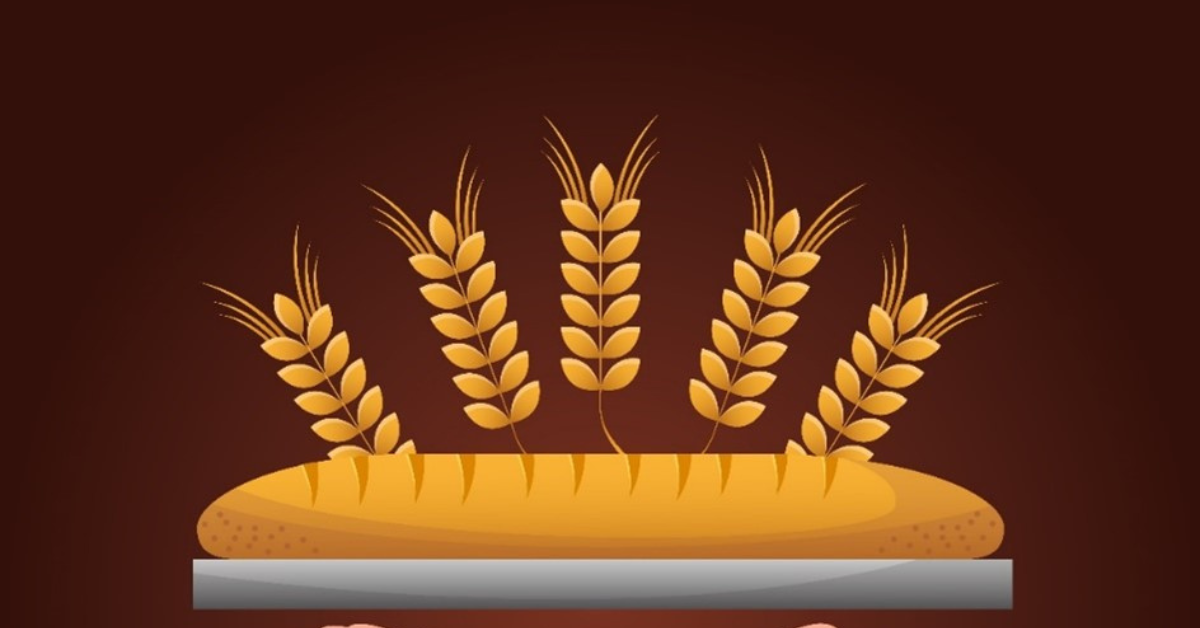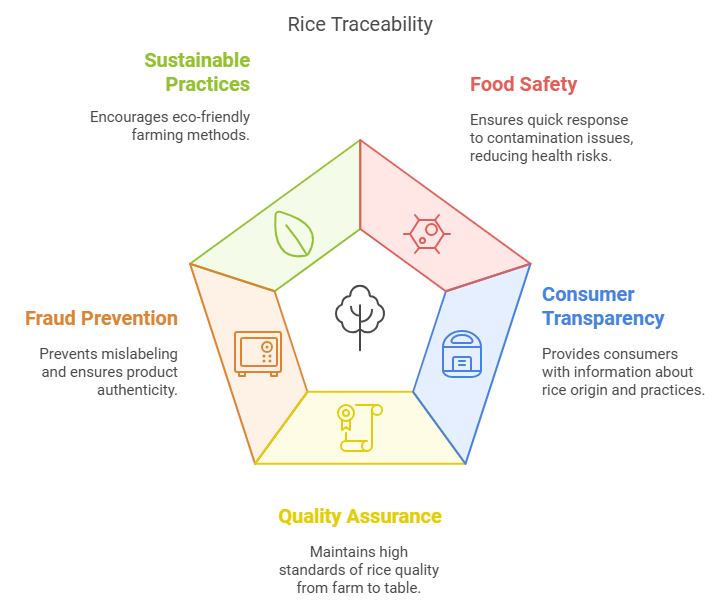Contact: +91 99725 24322 |
Menu
Menu
Quick summary: The volume of rice produced around the world has created a need for a robust system that can track paddy through its journey in the supply chain to ensure safety and security and promote sustainable and climate resilient food production through blockchain traceability solutions.

The rice supply chain is one of the most intricate and vital networks in global agriculture, feeding billions and supporting the livelihoods of countless smallholder farmers. Despite its critical role, it often faces significant challenges, including lack of transparency, food safety risks, and inefficiencies that lead to financial losses.
Asia accounts for 90% of global rice production, making countries such as China, India, Bangladesh, Indonesia, and Vietnam crucial to the world’s rice supply.
Imagine not being able to trace where your rice comes from or how sustainably it was produced—this lack of visibility can undermine trust, limit market access, and hinder efforts toward sustainability. Traceability solutions offer a transformative opportunity to overcome these barriers, bringing transparency and accountability to every step of the rice supply chain.
Key Takeaways
India is the second largest producer of rice in the world after China, accounting for 20 % of world rice production. About four-fifth’s rice in the world is produced by smallholder farmers and is consumed locally. India has the largest area under paddy in the world, occupying 43.39 million ha
Rice grows on a variety of soil like silt, loams and gravel and is composed of 68% water, 28% carbohydrates, 3% protein, and negligible fat. On average rice provides 20% of the world’s dietary energy supply. In 2021-22 about 509.87 million metric tons of rice were consumed worldwide.
Indian Rice market is projected to register a CAGR of 2.7% in the forecast period 2022-27. According to Rice Exporters Association, Indian rice exports touched 20 million in 2021, that included 16 million ton of non-basmati rice. The high demands from the US and European markets are supporting growth of this market. The major rice producing states are West Bengal, Uttar Pradesh, Andhra Pradesh, Tamil Nadu, Odisha and Bihar.
The rice supply chain is the journey that rice takes from the field to your plate, and it’s more complex than you might think! It starts with farmers who grow and harvest the rice. After harvesting, the rice is sent to mills where the outer husks are removed, and the grains are processed and polished, making it ready for consumption.
From there, the rice moves through traders and distributors, who may export it or transport it to different regions. It then reaches wholesalers, retailers, and markets before finally ending up in households, restaurants, and shops where we buy and eat it.
But managing the rice supply chain is not always smooth sailing. There can be issues with quality control, food safety, or even ensuring that farmers get fair pay. Keeping track of where the rice comes from, how it’s grown, and how it reaches us is critical to make sure it’s safe, sustainable, and supports everyone involved—from the farmers to the consumers. That’s where traceability comes in, giving everyone a clear picture of how rice moves through the supply chain.
Sustainability in rice cultivation is all about finding ways to grow rice that are good for the environment, support farmers, and ensure there’s enough rice for everyone in the long run. It focuses on using smarter farming methods that reduce waste, use fewer resources like water and fertilizers, and protect the health of the soil and nearby ecosystems.
Traditional rice farming often uses a lot of water because fields are flooded. This not only wastes water but also releases methane, a potent greenhouse gas. Sustainable practices, like Alternate Wetting and Drying (AWD), allow farmers to use less water by letting the fields dry out at specific intervals. This not only helps the planet by reducing water use and cutting emissions but can also save farmers money on water costs.
Other methods include using better-quality seeds, rotating crops to keep the soil healthy, and reducing chemical inputs. Sustainability also means making sure farmers earn a fair wage and are supported with training and resources to adopt these practices.
A leading agribusiness exporter partnered with TraceX’s sustainability platform to transform their basmati rice production process. By implementing sustainable practices, the company successfully reduced environmental impacts such as water usage, carbon emissions, and waste. TraceX’s digital solutions enabled real-time monitoring, improved traceability, and provided transparency across the entire supply chain. As a result, the company not only met international sustainability standards but also set new benchmarks for responsible practices in rice cultivation. This transformation helped the agribusiness enhance its brand reputation, appeal to eco-conscious consumers, and contribute to global sustainability goals.
In the quest for more sustainable rice cultivation, two innovative approaches have gained attention: Direct Seeded Rice (DSR) and the System of Rice Intensification (SRI). Both methods offer a way to reduce water use, cut down on greenhouse gas emissions, and improve crop yields—benefiting farmers and the environment alike. By integrating practices like DSR and SRI, farmers can cut down on water usage, reduce methane emissions, and achieve better productivity—all while protecting the environment. These sustainable methods also align well with broader goals of improving the resilience of rice cultivation against climate change, ensuring that rice farming remains viable and environmentally friendly for generations to come.
The Sustainable Rice Platform (SRP) is a global initiative focused on promoting environmentally-friendly, economically viable, and socially responsible rice production. Launched in 2011, it is led by a coalition of public, private, and civil society organizations, including the United Nations Environment Programme (UNEP) and the International Rice Research Institute (IRRI). The SRP aims to transform the rice sector through standards, tools, and innovative practices that make rice cultivation more sustainable.
The SRP developed a set of standards and performance indicators specifically for sustainable rice cultivation. These standards provide clear guidelines on efficient water management, reducing greenhouse gas emissions, promoting biodiversity, and improving labor conditions. Farmers and producers can use these standards to evaluate and improve their practices, ensuring that their methods meet sustainability goals while maintaining or increasing their productivity.
Agribusinesses face several challenges in the rice supply chain, including:
Addressing these challenges through innovative solutions like TraceX’s platform can help agribusinesses streamline operations, ensure sustainability, and foster transparency in the rice supply chain.
Traceability in the rice supply chain is all about knowing exactly where the rice you eat comes from and what it goes through before reaching your plate. Think of it like being able to track a package you ordered online, but instead, you’re tracking every stage of rice—right from the farmer’s field to the store shelves.
The journey of rice is complex. It starts with farmers growing and harvesting the grains. After that, rice goes through processing mills, distribution centers, and maybe even across different countries before you buy it at a market. Each step can impact the quality and safety of the rice, and without traceability, it’s hard to guarantee that everything is being handled responsibly.
With traceability systems, you can trace back to see if the rice was grown sustainably, whether farmers used eco-friendly practices, or if it met quality and safety standards during processing. This builds trust and helps ensure that only high-quality rice reaches consumers. For instance, if there’s ever a food safety issue, traceability makes it easier to pinpoint the source of the problem quickly.

Modern traceability often uses tools like blockchain and digital records to track every step of the rice supply chain. By using these technologies, every transaction, movement, and detail about the rice’s journey gets recorded transparently. This way, both companies and consumers can be sure they’re supporting ethical and sustainable practices, while also reducing fraud or waste in the process.
Srinergy Farms partnered with TraceX to digitize their paddy supply chain, marking a significant step toward achieving sustainable agriculture. By leveraging TraceX’s digital solutions, Srinergy Farms gained access to advanced crop management practices, which enabled them to monitor crop health, optimize irrigation, and enhance overall farm productivity. This digitization not only improved operational efficiency but also helped the farm achieve more profitable yields while adhering to sustainable practices.
The TraceX Farm Management Platform is a comprehensive digital solution designed to help farmers and agribusinesses streamline their operations, enhance productivity, and ensure sustainability. It offers real-time monitoring and tracking of farming activities right from sowing to harvesting, empowering farmers with data-driven insights.
By leveraging technologies like blockchain, the platform ensures full traceability and transparency throughout the farming process. It records and verifies every step in the crop production journey, helping farmers adopt sustainable practices, optimize resource usage, and maintain quality standards. The platform also connects different stakeholders, from farmers to supply chain managers, facilitating better collaboration, accountability, and compliance with industry regulations.
Ultimately, the TraceX Farm Management Platform not only helps farmers improve yields and reduce costs but also supports agribusinesses in meeting their sustainability goals and building consumer trust.
Traceability in the rice supply chain offers a game-changing opportunity for transparency, quality assurance, and sustainability. By embracing traceable practices, stakeholders can ensure food safety, mitigate risks, empower farmers, and foster a resilient, ethical supply chain that benefits everyone from farm to fork. Investing in traceability is more than compliance; it’s a commitment to building a better, more sustainable future for rice production.
Traceability ensures transparency, food safety, and authenticity in the rice supply chain by tracking every step of the journey, from farm to consumer, minimizing risks and ensuring compliance.
It helps combat issues like fraud, quality inconsistencies, contamination risks, and inefficiencies by offering clear visibility into every stage of production and supply.
Farmers gain access to premium markets, improved income, better recognition for sustainable practices, and data-driven insights for optimizing their production processes.
